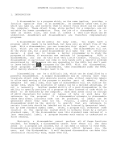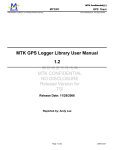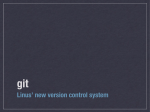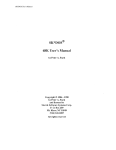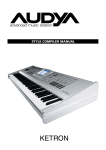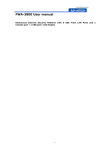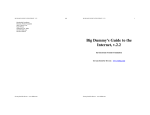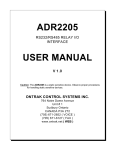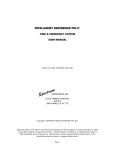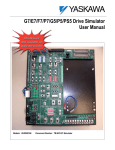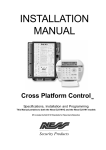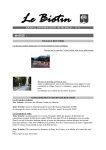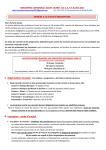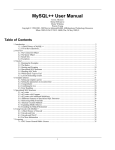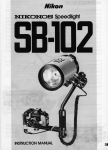Download IN THIS ISSUE
Transcript
IN THIS ISSUE 68 News Asked to Stop Publication 2 Single-Drive Backup 3 Mike Herman's program to backup floppy disks if you only have a single floppy drive Beginner's Corner 5 More on programming by Ron Anderson Print Spooling on the PT68K 12 Mike Randall's print spooler program saves time A Modified LIST Utility 23 David Underland improves the LIST program More Programming Tricks 26 From Gordon Reeder's Bag of Tricks Issue No. 11 November 1990 SK*DOS Update 30 The Star-K BBS System 31 2 68 News 68 News Asked to Stop Publishing Just about the time we mailed out the previous issue of 68 News, we learned that a new "68" magazine has been formed. It seems that this past summer, when we fell a few months behind schedule, some of our good friends took that to mean that 68 News was dead. And so they decided to start another newsletter, tentatively called The 68xxx Machines. We have now been asked to stop publishing 68 News, send The 68xxx Machines our subscription list, transfer our subscribers to them, and send them our articles and ads to be published there. The 68xxx Machines will be a bit different from 68 News. While their per-issue subscription rates will be somewhat lower than ours ($1 per issue for them, vs. $1.67 per issue for us), their ad rates are generally much higher ($75 for a half page in The 68xxx Machines vs. $10 for a half page in 68 News). To get the advertisers to help pay for the costs, The 68xxx Machines will have to cover a hardware and software from many vendors. In other words, The 68xxx Machines would cover not just SK*DOS, but also perhaps OS-9. or Minix (a Unix clone) ,as well as other hardware and software. The idea is to form a common magazine, replacing the many newsletters that individual vendors now send out themselves. On the surface. I think this is a fine idea. The 68xxx world is small. and bringing it together under one roof can be beneficial to all. Bull have several reservations. When a magazine has to cover many different systems, the space devoted to anyone has to be limited. There just may not be enough room for the material anyone of us wants to see, and there may be much that we have no interest in. Second, on a long-term basis, a magazine that relies heavily on advertisers must of necessity follow the majority of its readers. For example, some of the people involved with setting up the magazine are heavily into the Radio Shack Color Computer (CoCo). Since there are so many more CoCos than almost anything else, the magazine might tum into a CoCo magazine, for all I know. I have seen cases where one vendor or group managed to take over a magazine and effectively downplay or even exclude other points of view. Whether it was preferential treatment from the publisher, or just a simple matter of one prolific vendor flooding the magazine with news releases, ads. articles. and photos, the ultimate effect is the same - a stilted, one-sided, unfair magazine. For example, I remember one vendor who wrote a monthly column (and even gave talks at meetings organized by the magazine), which turned out to plug all his own products and ignore everyone else's.1l was designed to look impartial, but was in fact a free advertisement which made it look as though the magazine supported his products above those of other advertisers. I have no indication that this will happen with The 68xxx Machines, but I am afraid that it might. As a result. I have decided to go with The 68xxx Machines's suggestion on a trial basis. If the first issue comes out in January as expected, then you will receive an issue of The 6&o:x Machines instead of 68 News. Beyond that, things are less certain. I suspect that the ultimate solution may be to substitute The 68xxx Machines on an issue-for-issue basis, but still come out with an occasional issue of 68 News to cover material which may not be appropriate for The 68xxt Machines, or for which they may simply not have room. Let me know What you think. November 1990 3 Single-Drive Backup Program by Mike Herman Here is a useful program for those of us running SK*OOS on a system with just one floppy drive and too little memory for a RAMdisk. It is a backup program which allows making a copy of an entire disk on just one floppy drive. It copies as much of the disk into memory as fits, asks you to insert the destination disk, and copies the data out to the disk. If the memory is not large enough, then it asks you to swap disks several times, until the entire disk is copied. * SDBAC!ruP - SINGLE DRIVE BAC!ruP FOR SX*DOS 68000 * * * * * * ORIGINAL BY MlXE HERMAN, 9/90 MODIFIED AND EXPANDED BY PETE STARX 11/17/90 TO SAVE SPACE, WRITTEN FOR l56-BYTE SECTORS. IF SECTOR LENGTH IS CHANGED TO 512, CHANGE 352 TO 608 IN TWO PLACES BELOW LIB SXEQUATE LIBRARY FILE ORG $0000 START ADDR + OFFSET SDBACXUP BRA.S DC.W START $0100 GOTO START VERSION NUMBER START MSG1(PC),A4 PSTRNG GETNXT #$30,D5 MAXDRV(A6),D5 HELP POINT TO INIT MESSAGE GO PRINT READ DRIVE NUMBER CONVERT FROM ASCII CHECX IF VALID DRIVE ON ERR XFER LEA DC DC SUB.B CMP.B BHLL * SET UP REGISTERS TO GO AHEAD MOVE.L MOVE.L MOVE.B MOVE.W DC BNB.L CLR.L MOVE.W MOVE.L SUB.L CLR.L MOVE.B AND.B CMP.B BNB.L D5,DO A6,A4 D5,FCBDRV(A4) #$0003,FCBCTR(A4) SREAD ERROR D1 FCBDAT+38(A4),Dl MBMBND(A6) ,AO #610,AO D2 FCBPHY(A4) ,D7 #$FO,D7 #$10,D7 NOTFLO * REGISTER USAGE: * DO=DRlVE NUMBER SAVE DRIVE NUMBER POINT A4 TO USRFCB INSERT DRIVE No INTO FCB INSERT TR 0 SECT 3 READ SIS Dl=LAST TRACX/SECT AO=BND OF BUFFER CHECX IF FLOPPY EXIT IF NOT FLOPPY D1.W=LAST TRACX/SBC ON DISX * D2 . W=LAST TRltISBC READ * AO=BND OF BUFFBR D3=RBAD FLAG A1=LAST BUFFBR USBD D4=BOF FLAG 68 News 4 * * READ SECTOR DATA READ WaITE CLR.L D3 CLEAR FLAG: NOTHING TO CLR.L LEA DC DC D4 ASltSRC ( PC) , A4 PSTRNG GETCH ALSO EOF FLAG ASK FOR SOURCE DISK GO PRINT READ INPUT OF CR WHEN LEA FCBUFF(PC) ,A4 POINT TO BUFFER BEGINNING ADD.B CMP.B BLS.S ADD.W MOVE.B CMP.W BLS.S MOVE.B BRA.S #l,D2 D1,D2 SECTOK #$0100,D2 #1,D2 D1,D2 SECTOK #$1,D4 WRITE NEXT SECTOR TIME TO GO TO NEXT TRACK? NO YES, NEXT TRACK AND SECTOR 1 PAST END OF DISK? NO YES, SET EOF FLAG AND GO WRITE OUT ALL TO MOVE.B MOVE.W DO,FCBDRV(A4) D2,FCBCTR(A4) SREAD ERROR #1,D3 READY RLOOP DATE SECTOK DC BNE.L MOVE.B PUT DRV NO INTO FCB AND TRACK/SECTOR READ SECTOR INTO BUFFER EXIT ON ERROR SET FLAG: SOMETHING TO WRITB ADD.L CMP.L BHI.S * * #352,A4 A4,AO RLOOP NEXT BUFFER AREA AT END OF BUFFER? NO, CONTINUE WRITB SBCTOR DATA * WRITB TST.B BEQ.S MOVE.L DC DC D3 DONE A4,A1 ASKDES(PC) ,A4 PSTRNG GETCH ANYTHING TO WRITE? NO, SO EXIT SAVE LAST BUFFER ADDRESS ASK FOR DESTINATION DISK GO PRINT READ INPUT OF CR WHEN LEA FCBUFP ( PC) , A4 POINT TO BUFFER BEGINNING WLOOP CMP.L BNE.S TST.B BEQ.S BRA.S A4,A1 WRITIT D4 READ DONE AT BND OF BUFFER? NO, SO WRITE IT CHECK EOF FLAG READ MORE IF NOT EOF ELSE QUIT WRITIT DC SWRITE ERROR #352,A4 WLOOP ELSB GO WRITB THB SECTOR ERROR OUT THEN GO TO NEXT BUFFBR LEA READY BNE.S ADD.L BRA.S November 1990 5 * ALL DONE * DONE DC WARMST RETURN TO Slt*DOS * * ERRORS AND MESSAGES * DC.B DC.B HLPMSG(PC) ,A4 PSTRNG WARMST "SDBACltUP is a single-drive floppy disk backup utility." $D,$A "The correct syntax is SDBACKUP ",$04 DC MOVE.B DC DC DC PCRLP #$07,D4 PUTCH PERROR WARMST NOTFLO DC LEA DC DC PCRLF NTFMSG(PC),A4 PSTRNG WARMST Msal ASKSRC ASKDES NTFMsa DC.B DC.B DC.B DC.B "SINGLB DRIVE BACKUP ",$04 "Insert source disk ••• CR when ready", $04 "Insert destination disk ••• CR when ready ",$04 "Specified drive is not a floppy disk.",4 HELP HLPMSG ERROR LEA DC DC DC.B BEEP * EVEN FCBUFF DS.B 1 BEGINNING OF BUFFER END SDBACKUP Beginner's Corner by Ron Anderson I guess we ought to change the name of this to Assembler Comer, at least for the time being. Rather than forge on ahead very quickly into files and file handling, I thought perhaps we ought to spend a little more time on our program to add numbers. First, let's start with the program from last month and fix a deficiency. DECIN, as you will recall, won't accept negative numbers. Let's fix that problem by modifying our subroutine GETS1R. Since that routine is going to get more specific, I am going to rename it GETNUM. We'll fix it so that it looks to see if the first character it sees is a "-". If so, we'll tuck away that information and not put the minus sign in S1RBUF. Then later, when we return from DECIN, we will check whether the value is negative and NEGATE the number if that is the case. It is easier to do than to describe in words. Program ADD4 meets these requirements and brings up an example of something I mentioned previously but didn't explain at the time. I said that the 68 News 6 designers of the 68000 had placed a limitation on programmers. If a variable is tucked away along with the program access to it is limited. Look at the ADD4 listing below. The variable SIGN is declared at the end of the program. I can do this: KOVB.B SIGN(PC) ,DO but the following is illegal: KOVB.B DO,SIGN(PC) PC relative addressing can be used to read the value in a variable, but not to write a value to the variable. Instead we must go through two steps to use another addressing mode (We haven't formally talked about addressing modes yet). LEA SIGN(PC) ,AO KOVB.B DO, (AO) This method will always work: for writing to a memory location. Now I'll include the listing of ADD4. I've started with a fresh uncommented version and only commented the changes. * ADD TWO NUMBERS INPUT BY USER NAM ADD4 * EQUATES VPOINT EQU $AOOO WARMST EQU $A01E PSTRNG EQU $A035 PCRLF EQU $A034 OUT5D EQU $A038 DECIN EQU $A030 GETCH EQU $A029 LPOINT EQU 758 START DC VPOINT MOVB.L A6,AO LEA MSG1(PC) ,A4 DC PSTRNG BSR.S GETNUM CHANGED SUBROUTINE LEA STRBUP(PC),A1 KOVB.L A1,LPOINT(AO) DC DECIN KOVB.B SIGN(PC),D1 GET THE NEGATIVB SIGN PLAG BEQ. S ADD1 IF ZERO. NOT NEGATIVB NEG.W D5 OTHERWISE NEGATE THE NUMBER ADD1 KOVB.W D5,DO LEA KSG2(PC).A4 DC PSTRNG BSR.SGETNUM LEA STRBUF(PC).A1 KOVB.L A1,LPOINT(AO) DC DECIN KOVB.B SIGN(PC) ,D1 SAME COMMENT AS ABOVB BEQ.S ADD2 NEG.W D5 ADD2 ADD.W D5,DO LEA MSG3(PC).A4 DC PSTRNG November 1990 7 CLR.L D5 MOVE.W DO,~ DC 0U'l'5D DC WABMST * eDTNUM SUBllOU'l'INB GBTNUM LEA STRBUP(PC),A1 LEA SIGN (PC) ,A2 POINT AT SIGN VARZABLE CLR.B (A2) SET SIGN PALSB GBT1 DC GETCR CMP.B 1'-',D5 SBB IP PIRST CBARACTBR IS MINOS SIGN BNB • S GBT2 IP NOT, ALL IS OK MOVE.B I$Pp, (A2) IP SO, SET SIGN PLAG NON-ZBRO BRA.S GBT1 DON'T PU'l' "_a IN BUPPBR GET2 CMP.B '$20,D5 PROM RBRB ON TRBRB ARB NO CHANGBS. BBQ. S DONGET CMP.B '$OD,D5 BBQ.S DONGBT MOVE.B D5, (A1)+ BRA.S eDT1 DONGBT MOVE.B I$OD, (A1) RTS MSG1 DC.B "INPU'l' PIRST HOMBD ",$04 MSG2 DC.B "INPU'l' SBCOND HOMBD ",$04 MSG3 DC.B "SOM lSI ",$04 SIGN DC.B 1 STRBUP DS.B 30 BND STUT Our program is growing. Note near the beginning of the program we have used MOVE.B SIGN(pc),Dl. That instruction is followed by a BEQ.S. We haven't talked about the condition code register yet, but let me just say that simply moving a value to a data register causes the value to be tested and some condition codes seL The test for zero is done automatically and the condition code register ZERO FLAG is set appropriately so that the BEQ (branch if an equality test results in a zero value) works after simply moving the value to a register. You might be thinking that we have done a lot of manipulation to get our "flag" set and cleared and stored away in the SIGN variable. You are absolutely C~L Since I've use Dl in the process, why not eliminate the variable SIGN ,nd simply keep track of it in D1. Listing ADDS follows, and it does just that. * ADD TWO HOMBBRS INPU'l' BT OSD HAM ADDS *BQOATBS VPOINT BQO $AOOO WARMST BQO $A01B PSTRNG BQO $A035 PCRLP EQO $A03 .. 0U'l'5D BQO $A038 DBCIN BQO $A030 GBTCR BaO $A029 8 68 News LPOIN'l' BQU 758 START DC VPOIN'l' MOVB.L A6,AO LEA MBG1 (PC),M DC PSTRNG BSR.S GBTNUM LEA STRBUF(PC),A1 MOVB.L A1,LPOIN'l'(AO) DC DBCIN TST.B D1 IF NOT ZBRO, SIGN IS NlQATIVB BBQ.S ADD1 NEG. W D5 NEQATB NUMBBR IF NEQATIVB FLAG ADD1 MOVB. W D5, DO LEA MBGl (PC) ,A4 DC PSTRNG BSR.S GRTNUM LEA STRBUF (PC) , A1 MOVB.L A1,LPOIN'l'(AO) DC DRCIN TST.B D1 BBQ.S ADDl NEG.W D5 ADOl ADD.W 05,DO LEA MSG3 (PC) ,A4 DC PSTRNG CLR.L D5 MOVB.W DO,D4 DC OUT50 DC WARMST * GBTNUM SUBROUTINE GBTNUM LEA STRBUF(PC),Al CLR.B D1 SET SIGN FALSB OR POSITIVB GBT1 DC GBTCH CMP.B 1'-',D5 BNI.S GBTl MOVB.B I$FF,D1 SET SIGN NBGATIVB BRA.S GRT1 DON'T PUT "-" IN BUFFO GBTl CMP.B l$lO,D5 BBQ.S DONGBT CMP.B I$OD,D5 BBQ.S DONGBT MOVB.B D5, (A1)+ BRA.S GBT1 DONGBT MOVB.B I$OD,(A1) RTS MBG1 DC.B "INPUT FIRST NUMBBR ",$04 MSGl DC.B "INPUT SBCOND NUMBBR .. , $04 MBG3 DC.B "SUM IS. ",$04 STRBUF DS.B 30 BND START November 1990 9 Obviously the new version is simpler and has fewer instructions. Maybe not quite so obviously it is not as easy to follow for anyone but the author. A comment line: * Dl is used to keep track of the sign of the input value would surely help clarify the program. In fact, at the beginning of the main program and at the start of any subroutine, it would be a good idea to document the register usage. This is sometimes of great value in debugging a complex program. You can more easily find that you have used a register in a subroutine that was holding something important in the main program or a higher level subroutine. Now that we have a program that will accept negative values, how about one more improvement. Let's make it so that it will accept numbers until you enter a zero and then print the total. Numbers may be positive or negative. The negative numbers are to be identified by preceding them with a "_" just as we have done so far. The only difference will be to change the prompts from "Enter First Number" and "Enter Second Number" to "Enter Number". We will do an unconditional branch back to get another number and add it until the number is zero and then we will print the total and exit. It will be smaller than our previous program: * ADD NUMBERS INPUT BY USER UNTIL ZBRO IS INPUT NAN ADD6 * EQUATES VPOINT EQU $AOOO WARMST BQU $AOIE PSTRNG EQU $A035 PCRLF EQU $A034 OUT5D EQU $A038 DECIN EQU $A030 GETCH EQU $A029 LPOINT EQU 758 START DC VPOINT GET POINTER TO Slt*DOS VARIABLES MOVE.L A6,AO SAVE POINTER TO VARIABLES CLR. W DO TO HOLD SUM OF ENTRIES ADDO LEA MSGl(PC),A4 DC PSTRNG BSR.S GBTNUM LEA STRBUF(PC) ,AI MOVE.L Al,LPOINT(AO) DC DECIN TST.B Dl IF NOT ZERO, SIGN IS NEGATIVE BEQ.S ADDI NEG.W D5 ADDI ADD.W D5,DO CMP.W #O,D5 BNE.S ADDO IF NOT ZERO GO GET MORE LEA MSG3 (PC) ,A4 DC PSTRNG CLR.L D5 MOVE.W DO,D4 68 News 10 DC oUT5D DC WARMST * GETNUM SUBROUTINE GETNUM LEA STRBUP(PC),Al CLR.B Dl SET SIGN PALSE GETl DC GETCR CKP.B #'-',D5 BNE.S GET2 KOYB.B #$PP,Dl SBT SIGN BRA.S GETl DON'T PUT GET2 CMP.B #$20,D5 BBQ.S DONGBT CKP.B #$OD,D5 BEQ.S DONGET KOYB.B D5, (Al)+ BRA.S GETl DONGBT KOYB.B #$OD,(Al) RTS KSGl DC.B "INPUT NUMBER KSG3 DC.B "SUM lSI ",$04 STRBUP DS.B 30 OR POSITIYB NEGATIYB IN BUPPER ",$04 BND START Make the changes in the previous program and assemble this one as ADD6. Gi ve it a try. This one assembled correctly on the first try and did what I expected it to do. Now you can balance your checkbook provided your balance never exceeds $327.67 nor is in the red by more than $327.68. (Just omit the decimal point in your entries). I'll leave it as the first exercise for you to work independently, to change the .W arithmetic to .L arithmetic. I believe DECIN will already work for Longs, but you will have to use OUTIOD rather than OUT5D in order to print out the longer number. When you get done, you can balance your checkbook if the numbers are less than about $20,000,000. If that is a problem for you,let me know and we will do a double precision long integer version that can handle the National Debt! On a different subject, it might be time to introduce afew more quirks in the 68000 instruction set (hereafter when I say 68000 I mean the entire family, it gets tiresome to write 68XXX all the time). There is a special short instruction that may be used to add a small amount to a register. Edit the following two line program and assemble it using ASM: ADD.W #1,00 ADDQ.W #1,DO END You will get the following listing: 00002 00000000 06450001 00003 00000004 5245 00004 00000006 add.w addq.w end #l,dS #l.dS Notice that the second line generates a shorter instruction (i.e. hex code) than the first. In fact the first is a 4 byte instruction and the second is only 2. The Q November 1990 11 (for Quick) version of Add and Subtract work for immediate values from 1 to 8. There were three bits left over in the instruction (speaking loosely) so the people who worked out the instruction set coded the immediate value right into the instruction. In the case of the regular ADD instruction the amount to be added is coded in the second word of the instruction (the 0001 in the above listing). Again, I will refer you to the 68000 user's manual or your book on assembler programming on the 68000. The situation here is similar to the one that we discussed in considering the branch instructions, BRA vs. BRA.S. The shorter form of the instruction is more limited in scope but it reduces the size of the object code and it runs faster, and so should be considered if speed is critical. With a megabyte of memory available, you might well ask why a programmer should worry about saving two bytes here and there, and the question is valid. Back in the days when a computer had 4K of memory, programmers Were very concerned about saving a few bytes, and some of this is a holdover from those days. Obviously with all that memory, space is no longer as important a consideration, but speed might be a larger one. Generally compilers ignore these shortcut instructions and use the BRA form and the ADD form without exception. This is a case of simplifying the compiler at the expense of a few more bytes of code. I ought to mention that some assemblers automatically choose the correct instruction. ASMK from Palm Beach Software, for example, will generate an ADDQ machine code wherever an ADD has a value within proper range. ASMK won't accept an ADDQ instruction, however. It wants to do it automatically and it balks with an error message if you try to tell it to use the ADDQ. ASMK does something else that is rather nice. If you use a BRA.. instruction, and it is within the range of a BRA.S, it will flag the instruction so you can change it. In this case, the assembler doesn't do it automatically, but it does tell you that you may do it. In a long program you may find that when you change all the flagged branch instructions to short branches, a few more will be brought within range, so the process is iterative. Perhaps this is why the assembler doesn't do it automatically. Our program from above yields the following when assembled with ASMK: 000000 5245 000002 4E7l 4E7l 4E7l *** add.w addq.w .l,ds 'l,ds UNRECOGNIZABLE MNEMONIC OR MACRO end It automatically generates the machine code for ADDQ on the ADD.W instruction, and it complains when you try to tell it to use ADDQ. If you look through the user's guide you will find a couple other versions of ADD. Both of the assemblers mentioned here handle those automatically. In the original instruction set we would have to use ADDI #32,D7. Both assemblers see the immediate sign (#) and generate the ADDI instruction. ADDA is also mentioned for use in adding to an address register. This is also handled by both assemblers. There are a few more subtle differences in the two assemblers that we needn't worry about for the present. 68 News 12 Well, next time we will get into reading from and writing to disk files, I promise. Perhaps at that point, you will be able to read and understand books on the subject without help. I truly hope these four articles have helped you to get started. Somehow it is difficult to get through that first step of firing up the computer and getting it to do something. Welcome to the world of computer programmers as opposed to being appliance users. Future columns will deal with using compilers and interpreters, and reviews of software that you can use. Print Spooling on the PT68K-2 by Dr. Michael RandaU (Editor's Note: Mike sent us the enclosed code for inclusion ill the 68 News, but did not enclose an article with it. I have therefore added the following paragraphs by way of explanation.) A print spooler lets you print a file at the same time as you do something else; the word spooler dates back to the early days of large computers, when the file was written to a spool of tape, to be printed at a later time. For example, a print spooler allows you to print out an assembly listing at the same time as you edit or assemble another file. Without a print spooler, you would have to wait until the printing is finished before you could edit or assemble the next file; the spooler allows you to do both at the same time. The computer can handle both jobs easily because printing keeps the printer busy, but involves relatively little work for the CPU. The print spooler is nothing more than a program (or actually, two programs in our case), which sets up a timer (the DUART in our case) to generate periodic interrupts. Each time this interrupt arrives, the CPU stops the current program (which may be an editor, assembler, or any other program you might be running), temporarily goes off to send the next character to the printer, and then resumes your program as if nothing had happened. Since the interruption is very short, you will generally never notice that the CPU went off to do something else for a moment. To use Mike's print spooler, you must do three things: Step 1. Prepare the file or files you want to print. For most normal text files, the file may already exist as .TXT files, in which case you need do nothing. In some cases, you may have to go out of your way to prepare the file. For example, to spool an assembly listing, you will have to tell the assembler to write a listing file, rather than print it directly. This could be done by redirecting its output to a file. For example, the command ASK TESTPILB -B 4.LISTFILE.OUT would tell the assembler to assemble lESTFILE, not generate a binary file, and send all output to a file called LISTFlLE.OUT on drive 4. (On my system, drive 4 is generally a RAMdisk, so this would be a strictly temporary file.) Step 2. Use the DEVICE command to load the PARSPOOL printer driver and call it PSPL. Thefollowing command would do the job: November 1990 13 DBVICB PARS POOL AT 3 AS PSPL Note that a different driver is needed; the normal PARALLEL driver you may have been using to date is not set up for spooling. Step 3. Use the PRINT command to send the file to the driver. In our example, the command would be PRINT LISTFILB PRINT is used here instead of LIST. Many of you have been using a command such as LIST PRTR to send a listing to a PRTR driver; now you would use PRINT instead. The PRINT command defaults to an extension of .OUT, so we did not need to add an .OUT after LISTFILE; for other extensions, you would need to add it. The PARSPOOL driver code follows: NAM PARSPooL.TXT OPT PAG LIB SKEQUATB.T~ PAG * * * * * * * * PARALLEL DEVICB DRIVER FOR SX*DOS/68X THIS VERSION IS CONFIGURID FOR THE PT-68X-2 COMPUTBR IT IMPLEMENTS PRINTBR SPOOLING USING DUART 2 TO GBNERATB TIMER INTBRRUP'l'S OCNTRL $0081 GIVES THB CALLBR ACCBSS TO THB SPOOL QUBUE DATA STRUCTURE IT IS BASBD ON PBTBR STAlUt'S "PARALLEL.T~" PARTS ADDBD ARB MARKED "+" PARTS CHANGBD ARB MARKED "X" * * * * * * THE FORMAT OF A DEVICE DRIVER FOR SX*DOS IS VERY RIGID, BSPBCIALLY AT THE BBGINNING AND VERY BND. YOU MAY SUBSTITUTB YOUR OWN DRIVER CODB, BUT MAKE SURE TO USB THE SAME FORMAT POR THB DRIV'ltR AS THIS BXAMPLE. NOTB BSPBCIALLY THAT THIS DRIVER IS NOT BXECUTABLEI IT IS TO BB LOADBD INTO MEMORY BY THB 'DEVICB' UTILITY, AND MUST BB POSITION-INDBPBNDBNT. **************** IMPORTANT II **************************** ** IP USING ASM.COM TO ASSEMBLE THIS PILE, CBANGB "PAG" ** TO "PAGB" IN LINES 2 AND 3, AND MAKE SURB TO ** USB THE -F OPTION ********************************************************** ******************.*************************************** * PART 1. BBGINNING, VERSION NUMBBR, AND A 'DN' MARKER * WHICH IS CHBCKED BY 'DBVICB' TO AVOID BRRORS. ******* •• ************************************************* START BRA.S START NEVER BXECUTBD DC.W $0001 DC.W $444B VERSION NUMBBR 'DN' ID MARKER ********************************************************** * PART 2. LENGTH SPBCIFICATION. THB NE~ LONG WORD DBFlNES * THB LBNGTH OP THB DRIVER TO DBVICB.COM. THBEND IS A * LABBL WHICH IS PLACBD AT THB VERY BND OP THE DRIVER + + + + + + 68 News 14 _._* ____ ***** ____ * __ •• _._ ••• ____ ._ •• *. ____ •• * •• *a._._._. _____ * ____ ._* _________ * _____________ .*.* __ ___ **_ •••• LENGTH * * w__ _ DC.L THEBND w__ * PART 3. BNTRY POINT POINTBRS. THE POLLOWING POINTBRS DBPINB THE BNTRY POINTS INTO THE DRIVBR. ALL ARB * ____ * ______ ** ORIGIN ____ ••• * _______________ * __ * __ w__ RBLATIVB '1'0. THB *_* __ _* ______ DC.L DC.L DC.L DC.L DC.L DC.L DC.L DC.L DC.L DC.L DC.L INIPOl INSTAT INCHAR INCHAN ICNTRL OUSTAl OUCHRl OCNTRl INSTAl INCHNl BPLUSH DRIVBR INITIALIZATION x INPUT STATUS INPUT CHARACTBR WITH ECHO INPUT CHAR WITHOUT ECHO INPUT CONTROL ENTRY OUTPUT STATUS x OUTPUT A CHARACTBR X OUTPUT CONTROL BNTRY X INPUT STATUS (1 cHAR ONLY) INPUT 1 CHAR ONLY, NO ECHO PLUSH TYPEAHEAD BOPPBR __ ._* __ •.• ________ * ___ ••• _______ • _____ *_ •• * ___ * __ *_* __ *.w_.w_ * PART ". THE POLLOWING LINB DBPINBS THE BBGINNING 01' THE ACTUAL * CODE AS BEING AT $0000. IT SERVBS TO BREAK UP THE OBJECT PILE * TO MAD IT POR 'DBVICB' TO LOAD INTO THE ****wwww.w ___ EASIER *_*** ____________ * _______ *. __ CORRICT * ___ * ___ PLACE. • __ ._* _____ ORG $0000 ** ____ * ____ ** ______ * ________________ *_ •• ___________ *_.*wwww __ * PART 5. DATA AREA USBD BY THE DEVICB DRIVBR POR VARIOUS _____________ * ____ * __ ._. ____ * _________ • __________ •• w__ * __ _ *_**PURPOSES. * * * * BYTES 0-121 NAMB 01' THIS DEVICE DRIVBR DISK PILE - 12 CHARACTERS PLUS 04 'PRTSPOOL' IS RBQUIRBD BY PRINT.COM WHICH SEARCHES TO + DEVICB TABLE POR A DEVICB WITH THIS NAMB + DRNAMB DC.B 'PRTSPOOL.DVR',4 X * BYTE 13: DEVICB NUMBER SO THIS DRIVBR KNOWS WHICH DEVICB IT IS DBVNUM DC.B 0 WILL BE PILLED IN BY 'DEVICB' * * * BYTES 14-17: ADDRESS 01' DEVICE DESCRIPTOR POR THIS DRIVBR DEVADD DC. L 0 WILL BE PILLED IN BY 'DBVICE' *~*********************************.****************** ******* * * * * * PART 6. DEVICS INITIALIZATION. THIS CODS .INITIALIZSS PORT A 01' THE 68230 .PI/T AT $PE0080 IN THB PT68K-2 COMPUTBR AND TIMBR INTBRRUPTS USING DUART 2. IT IS + ONLY EXECUTED WHEN LOADSD BY 'DEVICE'. ALL RBGISTERS CAN BE CHANGBD. November 1990 15 ************************************************************* • HARDWARE EQUATES POR THE PORTS PIT GENCON PADIR PACONT DATREG STARBG EQU BQU EQU EQU EOU EOU $PE0081 PIT PIT+4 PIT+12 PIT+16 PIT+26 BASB BOU $FB0040 ACR BOU BASE+$9 ISR BOU BASE+$B IMR BOU BASB+$B CTUR BOU BASB+$D CTLR EOU BASB+$P STARTC EOU BASE+$lD STOPC EOU BASE+$lP VEC5 EOU $74 DRVUSD BOU $113C SECTRD EQU $1020 DlREAD BOU $110C • INITIALISE TIMER INIPOl DC INTDIS LBA INT (PC) ,AO LEA SAVVBC(PC),Al MOVE.L VEC5,(Al) MOVE. L AO, VEC5 MOVE.B #$PO,ACR MOVE.B #$4,CTUR MOVE.B #$84,CTLR TST.B STOPC TST.B STARTC MOVE.B #8,IMR BSR.S INIPOR DC INTBNA RTS • • PIT ADDRESS GBNERAL CONTROL REG DIRECTION REG CONTROL REGISTER DATA REGISTER PORT STATUS REGISTER DUART2 BASB ADDRESS LBVEL 5 AUTOINTBRRUPT VECTOR DISABLE INTBRRUPTS MOVE.B MOVE.B MOVE.B MOVE.B RTS #O,GBNCON #$PP,PADIR #$78,PACONT #$10,GBNCON + + + + SAVE NORMAL VECTOR INSTALL NEW VECTOR TIMER MODB SBT UP + + + + 10ma INT CLEAR ISR[3] START TIMER CLEAN BNABLE TIMER INTERRUPT PRINTER INIT ENABLE INTERRUPTS INITIALISE PRINTBR PORT A POR UNIDIRECTIONAL OUTPUT, H2 PULSED OUTPUT MODE, Hl TO DETBCT RISING EDGB INIPOR + + + + + + + + + + + + START WITH GENERAL CTRL =0 8 OUTPUT BITS PORT A,SUBMODB 01,PULSBD BNABLB PORT *********************************************************** * PART 7. INPUT PORT STATUS CHEC~. THIS ROUTINE IS TO RETURN • TWO THINGS: 1. ZERO IF NO CHARACTBR IS READY, NON-ZBRO OTHERWISB • • 2. D5=0 IF NO CHARACTBR IS READY, BLSB THB NUMBBR OP • CHARACTBRS READY. IN NON-INTERRUPT SYSTEMS, D5 SHOULD • RETURN A 1; ONLY IN INTERRUPT-DRIVEN SYSTEMS WILL IT + + + + + + + 16 68 News * INDICATE A REAL NUMBER OF CHARACTERS IN INPUT BUFFER * PRESERVE ALL REGISTERS * ON THE PRINTER PORT, HOWEVER, THERE IS NO INPUT SO ZERO • NOTE CHANGES INTRODUCED IN VERSION 0004 I * THERE ARE NOW TWO INSTA- ENTRIES, ALTHOUGH BOTH DEFAULT * TO THE SAME ROUTINE IF THERE IS NO TYPEAHEAD BUFFER ON THE * INPUT PORT: INSTAT CHECKS TO SEE WHETHER THERE IS ANY CHARACTER * IN THE TYPEAHEAD BUFFER, WHEREAS INSTAl CHECKS ONLY TO SEE * WHETHER THERE IS A 'LAST' CHARACTER AT THE END OF THE BUFFER * WHICH HAS NOT YET BEEN INPUT WITH THE INCHNl ENTRY *********************************************************** INSTAT INSTAl MOVE.B #0,05 RTS EQU INSTAT NO CHARACTER READY *********************************************************** * PART 8. GET INPUT CHARACTER FROM PORT INTO 05 AND ECHO IT TO * THE OUTPUT PORT. IF NO CHARACTER IS READY, WAIT FOR IT. * PRESERVE THE PARITY BIT, AND PRESERVE ALL REGISTERS * ON THE PRINTER PORT, HOWEVER, THERE IS NO INPUT SO ZERO * THIS ENTRY USES THE TYPEAHEAD BUFFER, IF ANY *********************************************************** INCHAR MOVE.B #0,05 RTS RETURN NOTHING *********************************************************** * PART 9. GET INPUT CHARACTER FROM PORT INTO 05 WITHOUT ECHOING TO * THE OUTPUT PORT. IF NO CHARACTER IS RBADY, WAIT FOR IT. * PRESERVE THE PARITY BIT, AND PRESBRVE ALL REGISTBRS * ON THE PRINTBR PORT, HOWEVER, THBRE IS NO INPUT SO ZERO * NOTB CHANGES INTRODUCBD IN VERSION 0004 I * THBRE ARE NOW TWO INCH-- ENTRIES, ALTHOUGH BOTH DBFAULT * TO THE SAME ROUTINE IF THBRE IS NO TYPEAHBAD BUFFBR ON THE * INPUT PORT: INCHAN TAKES THE NEXT CHARACTER FROM THB TYPEAHEAD * BUFFBR (AND CLBARS THE INSTAl FLAG), WHBREAS INCHNl TAKES ONLY * THE CHARACTER FROM THB END OF THE TYPBAHEAD BUFFER, AND CLEARS * BOTH FLAGS. ********************************************.************** INCHAN INCHNl MOVE.B #0,05 RTS BQU INCHAN RETURN NOTHING *********************************************************** * PART 10. INPUT CHANNEL CONTROL. THIS DRIVER DOBS NOT * IMPLEMENT INPUT CONTROL, SO SIGNAL ERROR AND RTS *********************************************************** ICNTRL AND.B #$FB,CCR RTS RETURN NON-ZBRO BRROR *********************************************************** November 1990 17 * PART 11. OUTPUT STATUS. RETURN ZBRO IF OUTPUT IS NOT * READY, NON-ZBRO IF READY TO OUTPUT NEXT. PRESBRVE ALL REGISTBRS. IF NO HANDSHAKING IS USBD, OR IF HARDWARE * HANDSHAKING IS USBD, THEN SIMPLY CHECK BUSY BIT. ***************************************************.**----- * OUSTA1 OSX MOVE.L AO,-(A7) LBA SPAF (PC) ,AO TST.B (AO) BPL.S OCBRR BTST #O,STAREG MOVE.L (A7)+,AO RTS SAVE IF SPOOL NOT IDLE .. BSR OUSTAT RESTORE + + + + + + + --.. _*.----**--_._-_._----.--------------------.----*-----* PART 12. OUTPUT CHARACTBR FROM DS TO OUTPUT PORT. IF NOT * READY, JUST WAIT FOR IT. PRESBRVE ALL REGISTBRS (INCLUDING DS) .. _._ .. _-----_._-----------.--------------------_ ... ------ _ OUCHAR BTST.B #O,STAREG BBQ.S OUCHAR MOVE.B DS,DATREG RTS 00'CHR1 MOVE.L AO,-(A7) LBA SPAF(PC) ,AO TST.B (AO) BPL.S OCERR BSR.S OUCHAR MOVE.L (A7)+,AO RTS OCBRR MOVE.W #$FFF1,D4 DC $A032 OCNTR1 LEA SPMSG(PC),A4 DC PSTRNG DC WARMST CHBCK IF READY WAIT UNTIL READY OUTPUT THB CHARACTER SAVE ZBRO IF SPOOLING ACTIVE PRINT IF IDLE RESTORE + + + + + + + REDIRECT TO BRROR OUTPUT + + + BRROR IF SPOOLING NOT IDLE + + *_.------------_.----------._-------------------------*** PART 13. OUTPUT CHANNEL CONTROL. -------------*._---------_.------------_._------------. * $0081 USBD BY PRINT.COM OCNTR1 CMP.W #$81,D4 BBQ.S OCNT81 OCNTRL AND.B #$FB,CCR RTS + + + RETURN NON-ZBRO BRROR * RETURN PTR TO QUBUB DATA STRUCTURE IN DS.L OCNT81 MOVE.L AO,-(A7) SAVE AO LEA AQP(PC),AO MOW.L AO,DS MOVE.L (A7)+,AO RESTORE AO IBXIT OR.B #4,CCR SBT Z - NO BRROR llTS + + + + + + + 68 News 18 ***-************************************************* * PART 14. WHEN A TYPEAHEAD BUFFER * EXISTS, THIS FLUSHBS IT AND CLBARS BOTH INSTAT AND * INSTAl FLAGS TO INDICATE THAT ALL IS EMPTY. ************.**************************************** BFLUSH RTS IN THIS CASE DOBS NOTHING *=============.=================.===~================= ======= * INTBRRUPT ROUTINE FOR TIMER INTBRRUPTS + BTST #3,ISR + INT BNE.S TIMINT + MOVE.L SAVVBC(PC),·(A7) NORMAL INT ADOR ON STACK + RTS 00 TO NORMAL INT ROUTINE IF NOT TIMER INT + TIMINT TST.S STOPC TO CLEAR ISR[3] + MOVE.L AO,·(A7) SAVE AO ON STACK + LBA SPAF(PC),AO + TST.a (AO) + BNE.S SPXl IGNORE IF IDLE OR SUSPENDED + BTS'!' •. B #0, STARBG + BBQ.S sPXl IGNORE IF PRINTER NOT READY + MOVBM.L 00·D7/AI-A6,-(A7) SAVE REGISTERS + *SPOOL OPBRATIONS + LBA SPFCB(PC),A4 + BSR TREAD + BBQ.S BOF + TST.S DS + IGNORE NULLS BBQ.S SPBXIT + BSR OUCHAR MOVE.B DS,DATREG PRINT CHAR + BRA.S SPBXIT + LEA SPAF(PC) ,A2 A2=SPAF BOF + MOVE.B #1, (A2) SUSPEND + * on end-of-file or file error print form-feed + * and go to next file if any + MOVE.S #$C,DS + PRINT FF BSR OUCHAR + LEA AQP (PC) ,AO + MOVE.L (AO),AO + MOVE.S #0, (AO) FREB THB FILB DEF BNTRY + BUMP POINTERS « OPEN FILE IF ANY+ BSR BUMP SPBXIT SPXl MOVEM.L (A7)+,DO-D7/AI-A6 RESTORE REGS MOVE.L (A7)+,AO RESTORE AO RTE * BUMP POINTBRS LEA AQP(PC),AO BUMP MOVE.W #9,D5 MOVE.L 4(AO),(AO)+ SS2 DBRA 05,SS2 MOVE.L #0, (AO) BSR OPFI TST.S (A2) 8HI.S SS3 MOVE.B #0, (A2) MOVE 10 POINTBRS UP + + + + + + + + CLBAR LAST POINTER + + + IF IDLE (SBT BY OPFI IF Q EMPTY) + SBT ACTIVE IF SUSPBNDBD + November 1990 SS3 19 RTS + * OPEN FILB IF NRINQ # 0 + OPFI LBA NRINQ(PC),AO + TST.B (AO) + BNB.S OFl + MOVE.B #$FF,(A2) SBT FLAG TO INDICATB SPOOL IDLE+ RTS + OFl SUB.B #1, (AO) ADJUST NR IN Q + LBA AQP(PC) ,AO + MOVE.L (AO),AO AOzFILB DBF STRING + LEA SPFCB(PC),A4 + MOVE.B 1(AO),FCBDRV(A4) + MOVE.W 14(AO),FCBCTR(A4) + LEA COUNT(PC),AO + MOVE.B #255, (AO) + RTS + UNUSED SPACE IN FCB FCBPTR BQU 80 + LEA COUNT(PC),AO TREAD + CMP.B #255, (AO) + BNB • S NXTBYT + * READ NEXT SECTOR + BSR SlREAD + BNB TRERR + MOVE.W FCBDAT(A4),FCBCTR(A4) LINK TO NEXT + MOVE.B #252, (AO) REDUCE COUNT + LEA 100(A4),A3 POINT TO 1ST DATA BYTE + BRA.S NBl + NXTBYT MOVE.L FCBPTR(A4),A3 GET DATA PTR + MOVE.B (A3)+,D5 + NBl MOVE.L A3,FCBPTR(A4) UPDATE DATA PTR + SUB.B #1, (AO) 0 WHEN LAST BYTE READ + BEQ.S LSTBYT LAST BYTE READ + RTS + LSTBYT TST.W FCBCTR(A4) + BEQ.S ITSEOF THAT WAS LAST SEC RETN WITH Z SET+ MOVE.B #255, (AO) Z NOW CLEAR + ITSEOF TRERR ~S + MOVE.B #8,FCBERR(A4) OR.B #4,CCR SET Z FOR EOF OR READ ERR RTS + + * SINGLE SECTOR READ - DON'T USE DC SREAD III SlREAD MOVE.B 3(A4),D5 AND.L #$F,DS MOVE.L #DRVUSD,A3 MOVE.B 0(A3,DS),FCBPHY(A4) JSR SECTRD JMP DIREAD + + + + + + + + *--------------------------------------------~-----------~--- + AREA + * DATA *------------------------------------------------------------ SAVVEC NRINQ SPAF DC.L 0 DC.B 0 DC.B $FF SAVE OLD VECTOR HERE NR FILES IN Q = SPOOLING IDLE, 1= SUSPBNDED, 0 = ACTIVE + + + + + 20 68 News ACTIVE QUEUE POINTER DC.I. 0 DC.I. 0,0,0,0,0,0,0,0,0,0 TEN Q POINTERS DC.I. 0,0,0,0 1ST FILB DEFINITION STRING DC.L 0,0,0,0 DC. I. 0,0,0,0 DC.I. 0,0,0,0 DC.w 0,0,0,0 DC.I. 0,0,0,0 DC.L 0,0,0,0 DC.I. 0,0,0,0 DC.L 0,0,0,0 DC.L 0,0,0,0 TEN FILE DBF STRS SPFCB SPOOLER FCB BQU * RPT 38 X16=608 DC.L 0,0,0,0 COUNT DC.B 0 SPMSG FCC IPRINT BRROR - SPOOLING ACTIVE/,4 .*.**************************************************** * THE BND. LABEL THEEND IS USBD TO CALCULATE LENGTH OF * DRIVER. NOTE THAT THERE IS NO TRANSFER ADDRESS. *************.***************************************** AQP QPO FSO THEEND EQU END + + + + + + + + + + + + + + + + * The following is the PRINT. COM program: NAM OPT PAG LIB PRINT. COM PAG SKEQUATB.TXT *-----------------------------------------------------.-----* PRINT.COM - BNTER FILE IN SPOOL PRINT QUBUE *------------------------------------------------------------ $A032 OCNTRL EQU PSPL EQU 'PSPL' * OFFSETS TO SPOOL DATA STRUCTURE -2 NRINO BOU -1 SPAP EOU a AOP EOU 4 OPO EQU FSO BQU $2C SPFCB EQU $CC $32C COUNT BOU START MOVE. X, DC AND. I. OR.W MOVE. I. #O,D4 OCNTRL #7.D5 #$FFFO,D5 D5,D2 GET CURRENT DEVICE IN D5 OCNTRL WORD FOR CURRENT DEVICE IN D2 * CHBClI: FOR PSPL DBVICE DC VPOINT MOVE. I. A6,A4 USE USRFCB * search the device table for a device named PRTSPOOL LEA SPNAME(PC),AO POINT TO NAME TO BE FOUND LEA DEVTAB(A6),Al POINT TO DEVICE TABLE 1ST ENTRY November 1990 21 CLR.L 01 START AT DEVICB 0 MOVB.L 4 (Al) ,A2 POINT TO START OP DRIVER CODB MOVE.L (A2) ,DO (AO) ,DO CMP.L BNE.S NOTIT 4 (Al) ,DO MOVE. I" CMP.L 4(AO),DO NOTIT BNE.S *WE HAVE POUND THB DRIVER (01) BRA.S NEWDBV #1,01 NOTIT ADD.B #8,01 CMP.B BBQ.S NOTPND WE COULD' T PIND IT #80,Al NEXT BNTRY IN DBVICB TABLE ADD.L BRA.S SRCH * REPORT DBVICB NOT INSTALLBD NOPSPL(PC) ,A4 NOTPND LEA DC PSTRNG DC WARMST * SAVE OCNTRL WORD POR PSPL DBVICB IN 01 NEWDEV OR.W #$PPPO,Dl * GBT PILB SPBC INTO PCB DC GBTNAM BCC.S EXTBN * REPORT IMPROPBR PILE SPEC - TELL USER THE RIGHT SYNTAX LBA BADPIL(PC),A4 DC PSTRNG DC WARMST EXTBN MOVE. I" #11,D4 ( .OUT) DC DBPEXT * SWITCH TO PSPL DEVICE Dl,D4 MOVE.L DC OCNTRL MOVE.W #$81,04 GBT PTR TO SPOOL DATA IN D5 DC OCNTRL MOVE. I" D5,A3 • SPOOL DATA STRUCTURE MOVE. I" 02,04 SWITCH TO PORMER DEVICB DC OCNTRL MOVE.B SPAP(A3) ,03 CURRENT SPAP SAVED IN 03 SRCH BMI.S MOVE.B Ii CMP.B BBQ * OPBN AND CLOSB Il #1,SPAP(A3) IP NOT IDLE I SUSPEND #10,NRINQ(A3) PULL NO PREE BNTRIES THB PILE DC POPBNR BNE ERROR DC PCLOSE BNE BRROR * GBT PREE BNTRY IN PILE DEP TABLE LEA PSO(A3),AO I2 TST.B (AO) LOOK POR PREE ENTRY BBQ.S I3 ADD.L #l6,AO NEXT ENTRY BRA.S I2 I3 MOVE. I" AO,Al A2,AO=PILE DBP ENTRY SPACE (NON-ZBRO) MOVE.B #$20, (AO)+ 22 68 News CPY * LEA MOVE •• MOVE.B DBRA BNTBR FILB DBF MOVE. I. MOVE.S ASL.II LEA ADD. I. MOVE. I. ADD.B MOVE •• 3 (A4) ,Al #ll,DO (Al)+,(AO)+ DO,CPy Al=FCB FILE DEF 12 BYTES TO COPY COpy FeB TO FILB DEF IN Q #O,DS NRINQ(A3) ,DS #2,DS X4 QPO(A3) ,Al DS,Al (Al) IS NEXT Q PTR A2, (Al) STORE FILE DEF ADDR #1, NRINQ (A3) UPDATE FCBFTR(A4),14(A2) 1ST TRXISEC TO FILB DEF * IF NOT IDLB RESTORE SPOOL STATB STSP SS2 * TST.B BMI MOVE.B DC D3 STSP D3,SPAF(A3) WARHST LBA MOVE •• MOVE. I. DBRA CLR.L SUB.B AQP(A3),AO #9,DO 4 (AO) , (AO) + DO,SS2 (AO) #1, NRINQ (A3) IF IDLB START SPOOLING MOVE 10 PTRS UP CLBAR LAST PTR INITIALISB SPOOL FCB LBA SPFCB(A3),A4 MOVE.S 1(A2),FCBDRV(A4) MOVE.. 14(A2),FCBCTR(A4) MOVE.S #2SS,COUNT(A3) MOVE.B #0,SPAF(A3) ACTIVATB SPOOLER DC WARHST FULL LBA DC DC QFULL(PC) ,A4 PSTRNG WARHST BRROR DC DC PBRROR WARHST *-----------------------------------------------------------* DATA AREA *------------------------------------------------------------ SPNAMB NOPSPL BADFIL FCC FCC FCC FCC queue/,4 QFULL FCC END IPRTSPooLI spool device driver filename ISPooL DEVICB PSPL NOT INSTALLBD/,4 ISyntax:- PRINT filespecl,$D,$A IInserts filespec (default .OUT) in spool print IPRINT SPOOL QUBUB FULL/,4 START If you want to avoid the effort of typing these listings in, the code for both of these programs is available for downloading from the Star-K BBS at (914) 241-3307. 23 November 1990 A Modified LIST Utility by David Underland I have found the LIST utility from the SK*OOS users manual to be very useful. However, I did find a few things annoying. First, the printer doe,S not formfeed after the listing is finished, and second, the lines per page count does not reset. Thus, the second listing will have the bottom and top of page margins inserted in the middle of the page. The following is a quick and dirty fix for this problem and also adds the ability to date stamp the top of a printout to help keep track of different versions of a program. I have the following line in my STARTUP. BAT file; dosparam 2 wd=80 p1=56 sl=10 This allows printing of 56 lines of text on a page with 10 lines skipped over the perforation. The problem is that the line counter in the print driver doesn't get reset after a listing is finished. To solve this situation, I added the following lines to the close subroutine at the end of the list program: MOVE.B DC MOVE.B #$OC,D4 PUTCH #$00,$D9P(A6) OUTPUT A PORM PBBD SBT PLINKS POR DBVICB 2 TO ZBRO The above outputs a form feed to the printer (the screen ignores it) and sets the line count (PLINES) to zero in readiness for the next printout. Note: if a print from another driver (assembler listing) is generated, it may NOT reset PLINES either, To be sure that the printer and the driver are ready for the next print out, do a manual formfeed on the printer and at the OOS prompt type: LIST LIST This will set the printer to top of form and reset PLINES in readiness for the next printout. While I was at it. I decided that since I am very careless about version numbers and dates of file creation that I would also add a date stamp to the listing routine. The following is inserted immediately after the opening of the file to allow the file name and date that the file was last stored to be printed at the top of the listing: *LETS PRINT THE PILB NAMB MOVE.L AO,A4 ADDA.L #4,A4 MOVE.L #7,D2 LOOP MOVE.B (A4)+,D4 BBQ BXT DC PUTCH DBRA D2,LOOP *NOW ADD BXTBNSION BXT MOVE.B #$2B,D4 DC PUTCH MOVE.L AO,A4 ADDA.L #12,A4 MOVE.L #2,D2 LOOP 1 MOVE.B (A4)+,D4 MAKE A4 POINT 0 PCB PILB NAMB STARTS AT BYTB 4 SBT COUNT POR 8 BYTB NAMB GBT THE CHARACTBR OP NAME IP ZBRO, NAMB SHORTER THAN 8 BYTES PRINT IT IP NOT DONK BRANCH PRINT A • GET PCB POINTER BACK BXTBNSION STARTS AT 12 TH BYTE SBT UP POR 3 CHARACTERS GBT THB CHARACTBR 24 68 News BEQ IP ZERO NO EXTENSION DATE DC PRINT IT PUTCH D2,LOOP1 DBRA BRANCH IP NOT DONE * LETS PRINT THB DATE THAT THE PILE WAS LAST SAVED DATE MSG(PC) ,1.4 LEA DC PNSTRN PRINT THE MESSAGE CLR.L D4 A6,A4 MAXB A4 POINT TO FCB MOVE.L MOVE.B FCBMONeA4l,D4 GBT MONTH OP FILE CREATION MOVE.L PRINT WITH OUT LEADING ZEROS 'OO,DS DC OUTSD OUTPUT IN DECIMAL MOVE.B #$2F,D4 DC PUTCH PRINT I MOVE.B PCBDAY(A4),D4 GET DAY OP MONTH DC OUT5D PRINT DAY IN DECIMAL MOVE.B '$2F,D4 DC PUTCH PRINT ANOTHER I MOVE.B FCBYER(A4l,D4 GBT YEAR DC OUT5D PRINT YEAR IN DECIMAL DC PCRLP PRINT CR AND LF The above will print a line at the top of the listing such as: LIST.TXT WAS LAST UPDATED ON 51 28/ 90 While this may not be fancy it does help keep track of different versions of a program. The complete. modified code is then this: LIB * LIST VER * *START START *LIST UTILITY FOR S~*DOS 168X *COPYRIGHT eCl 1986 BY PETER A. STARX * * EQUATES TO SX*DOS * snQUATB BRA.S START DC.W $0101 VERSION NUMBER OF ACTUAL PROGRAM DC PCRLF CLR.B D1 MOVE.L A6,AO MOVE.L A6,A4 DC GETNAM BCC.S NAMBOX MOVE.B '21,PCBBRR(A4' * *ERROR ROUTINE * ERROR DC PERROR BSR CLOSE DC WARMST *FILE SPEC WAS OX; DEPAULT TO .TXT NAMBOX MOVE. B '1, D4 DC DEFEXT * *NOW ACTUALLY OPEN THE FILE DC FOPENR November 1990 25 SNB.S BlUlOR *LETS PRIN'!' 'I'D FILENAME MOVE.L AO,A' ADDA.L ",A' MOVE.L '7,D2 NOVE.S (A,,.,D' LOOP SBQ BXT PUTCH DC D2,LOOP DBRA 1$2B,D4 EXT MOVE.S DC PUTCH MOVE.L AO,A' ADDA.L 112 ,A' MOVE.L '2,D2 LOOP 1 MOVE.B (A'I+,D' BEQ DATH DC PUTCH DBRA D2,LOOP1 *LETS PRIN'!' 'I'D DATB THAT 'I'D FILE WAS ClUlATBD. DATE LEA. MSG(PCI,A4 DC PNSTRN CLR.L D4 NOVE.L AO,A' NOVE.S FCBMON(A4I,D4 NOVE.B 1$00,D5 DC OUT5D MOVE.S 1$2F,D' DC PUTCH MOVE •• FCBDAY(A4I,D4 DC OUT5D NOVE.B 1$2F,D' DC PUTCH MOVE.B FCBYBR(A4I,D' DC OUT5D DC PCRLF DC PCRLF * *MAIN LOOP TO MAIN MOVE.L DC BBQ.S * *IF THBllB WAS CMP.B BNB BSR.S DC * READ AND PRIN'!' BACH CHARACTBll AO,A' FREAD CHAROK AN BlUlOR, SBB IF BND OF FILII #a,FCBBlUl(A41 BlUlOR CLOSE WARNST *CON'!'INUB IF CHARACTBR IS OK CHAROlt CMP.B '$OA,D5 BNB.S PRN'l'IT MOVE.S D1,D6 MOVE.B D5,D1 CMP.B I$OD,D6 SBQ.S MAIN PRN'l'IT NOVE.S D5,D1 26 68 News MOVE.B DS,D4 DC PU'l'CH CMP.B #$OD,D4 BNB.S MAIN MOVE.B I$OA,D4 DC PUTCH BRA.S MAIN * *CLOn StlBROU'l'INB * CLOn * MSG MOVE.L AO,u DC PCLOSB MOVE.B I$OC,D4 DC l'U'l'CH MOVE.B '00,$D9P(A6) IlTS DC. B DC.B .. WAS LAST UPDATED ON .. 4 BND LIST More Programming Tricks by Gordon Reeder, 618 Adrian Drive, Rolla, MO 65401 Here are some more tricks from my programing bag. What I have here is a group of four routines that help a programmer use the free memory that remains in a system after a program is loaded. I was writing a utility that would search for data in several files. To do this I needed several buffers; one to hold the list of files, one to hold the data I was looking for, and one to hold the data that was found. At this point I was faced with "programers dilemma #127", how large should I make the buffers?,] Should the file list buffer hold 8, 20, 50.100 files? If it was too small the usefulness of the program would suffer, if it was too large I would be wasting space. Wouldn't it be nice if I could have the buffer size determined at run time! It turns out that defining buffers at run time was easy to do. And now with these four routines~ you can do it too! The buffers are placed in the free memory that is left over after SK*DOS loads your program. The amount of memory left depends on the size of your program and the amount of DRAM in your system. The last available byte of memory is at MEMEND(A6). and the ftrSt byte is at ..• well now, just where does the free memory begin anyway? SK*DOS doesn't have a variable to point to the beginning of free memory, so we have to define our own, like this.•. PIlBB DC.L FIlEB+' end As you can see FREE has to be THE VERY LAST variable declared. In fact it has to be the last thing in the program before the 'end' statement. When the program is loaded into memory by SK*DOS, the first byte of free memory will be right after the variable FREE, and FREE will be pointing to it. Now that we can find the free memory we need a way to use it. The first routine is called GeCMem. It's almost trivial in its simplicity. All it does is read the value in FREE(pc) an return it in A4. So what? Well lincluded it for completeness. and November 1990 27 if you should want to add features to these routines you may find that you need a more complex GeCMem. Placing it here makes upgrading easier. The next routine lets you set aside a block of memory. The size of the block, in bytes, is placed in A4, then Res_Mem is called. Res_Mem will check to make sure that there is enough memory to hold the block you want. Here is how to use it to set upa buffer. bsr lea.l move. 1 * Get_Mem you need to know where buffer will start Buffer(pc),Al this is where we will save it A4,(Al) A4 has start address of the buffer it is now also in Buffer(pc) #1000,A4 lets make the buffer 1000 bytes long Res-"em buffer is now set error unless there wasn't enough memory move bsr beq Buffer ds.l 1 of course you need to declare this. Now if you should call GeCMem it will return the new value that is the first byte after your new buffer. The next routine does the same thing that Res_Mem does, but in a different way. Instead of telling how much memory you want to set aside, you tell Set_Mem what the absolute end address is. The example routine above using SeCMem would look like ... bsr start lea.l move. 1 buffer * add. 1 bsr beq Buffer Get-"em you need to know where the buffer will Buffer(pc),Al A4,(Al) this is where we will save it A4 has the start address of the #1000,A4 Set-"em error it is now also in Buffer(pc) lets make the buffer 1000 bytes long buffer is now set unless there wasn't enough memory ds.l 1 of course you need to declare this. Actually. SeCMem has a more useful function, As you will see shortly. The last routine doesn't even use the variable FREE, but it is useful for placing data into buffers so I included it here. PuCMem can be used in a loop to place data into the free memory. D5 is used to hold the character to be placed into memory (compatible with GETNXT) and A4 holds the address to receive the data. When the routine returns A4 will have been incremented to the next address. PucMem also checks for memory overflows. Here is a way that you can use PuCMem and SecMem to create a buffer that is exactly sized to its needs. bsr lea.l move. 1 * Get-"em you need to know where buffer starts Buffer(pc),Al this is where we will save it A4,(Al) A4 has start addres8 of buffer it i8 now a180 in Buffer(pc) Loop * read a byte of data (from a file or the keyboard, whatever) * the actual routine depends on your application 28 68 News * be sure to preserve the contents of A4 bsr.l Put_Mem put the data into free memory beq error oops, did we run out of memory? bra.s Loop * After all the data has been read AllDone bsr Set_Mem buffer is now set beq error unless there wasn't enough memory Buffer ds.l 1 of course you need to declare this. Now I don't know where you will be reading you data from, or how it's formatted. That's why I didn't include the code that gets the data or checks for the end of the input in the above routines. Maybe a word about what's going on is in order. The call to GeCMem returns the current value of the FREE. It is kept in A4 while one byte of input data is read. The input data routine needs to check for the out of data condition. If no more data is forthcoming then it should branch to AIIDone. If not, it should place the data into D5 (GETeR andGETNXT will already have done this). The call to PucMem places the data into free memory. Notice that this is free memory, not memory that has been reserved or otherwise set aside. The call to PuCMem will also increment A4 to the next byte. When all the data has been read A4 is pointing to what will become the new beginning of free memory. The call to SeCMem uses that value to update FREE, and set the new start of free memory. You are not limited to just one buffer. After one buffer has been set up you can use these routines to set up a second, and a third... You get the idea. In the program that I was writing that started all this, I set up four buffers. The end of the last buffer is never declared, I just use all available memory. Put these routines into a file and name it USEMEM.TXT. Now when ever you write a program that needs to use the vast expanse of memory in your system just include it with the statement lib usemem.txt The routines will be available to you with out having to type them into your source code. Well that's all for this time. But my bag of tricks is far from empty. So when I find some more useful routines I'll pass them along. What about you out there, yes, you reading this news letter. Do you have any tricks you know? Row about passing them along too. Free memory routines: GecMem returns the first available byte of free memory Res_Mem Reserves a block of x bytes of memory PucMem puts a byte into free memory Set_Mem sets the start of free memory at a user defined point All these routines use a long word 'FREE' that must be defined in the main body of the program. Like this ... *FRBE * DC.L end FRBE+4 start init to point just past program end of program November 1990 29 As you can see, the longword FREE must be the last declared variable * in the program. It comes right before the 'END' statement. * After SK*DOS loads the program, the first free byte of memory will be * directly after the variable FREE. And FREE will be pointing to it! .. . . .. . FIND FIRST FREE BYTE To call •.••• no arguments needed Exit ••••• A4 = first available byte of free memory Get_Mem move. 1 rts .. .. FREE(pc),A4 get value from FREE ••• •••• and return trivial, I know, but by placing it in a subroutine I can add features later. .********************************************* . Reserve memory . To calL •• . . ExitA4••• = how many bytes to reserve . A4 = First free byte past reserved block .. Z flag =0 = Memory overflow move. 1 move. 1 add. 1 cmp.l bge.s lea.l move. 1 move. 1 A1,-(A7) save A1 FREE(pc),A1 get Free pointer A1,A4 add offset MBMBND(A6),A4 see if there is enough mamory Mfull FREE (pc) ,A1 point too FREB pointer A4, (A1) save the new value (A7)+,A1 restore A1 rts .. What to do if we run out of memory Mfull andi #11111101,CCR clear Z bit in CC reg. rts ********************************************* . .. . SET MEMORY ROOTINE * to call .•• .. .. = A4 end of block +1 of a block of memory to reserve Bxit ••• .. Z flag =0 Memory overflow .. nothing changed *----------------~----,------------------- = move. 1 cmp.l bge.s lea.l move. 1 A1,-(A7) save A1 MBMBND(A6) ,A4 see if there is enough memory Mfull point too FREB pointer FREE(pC),A1 A4, (A1) save the new value 68 News 30 move. 1 (A7)+,Al restore Ai rts * What to do if we run out of memory Mfull andi #llllllOl,CCR clear Z bit in CC reg. rts ******************************************************* * * MEMORY INPUT ROUTINE * * * To call ••••• A4 Buffer pointer (auto inc) D5 = char to place in buffer * = Bxit ... = * A4 next Byte of memory * Z flag .0 = Memory overflow * Note: *This routine doesn't use the variable FREB. But A4 can be set *with a call to Get_Mem. After all the data has been placed into *memory, a call to Set_Mem will protect it. *---------------------------------------put_Mem cmp.l MBMEND(A6) ,A4 see if there bge.s move.b rts Mfull D5, (A4)+ is room in memory place char in memory return .. What to do if we run out of memory Mfull andi #11111101,CCR clear Z bit in CC reg. rts SK*DOS Update by Peter A. Stark The following change to SK*DOS will only be of interest to advanced . programmers, and I am including it here only in the interest of completeness. We have recently updated SK*OOS to version 3.2 by the addition of two new variables called DATBEG and MEMBEG. Both of these were put in at the request of Dr. Jack Crenshaw, who is writing a linker/loader called JINK for use with SK*OOS. Both variables can be accessed from programs by using the A6 register (which normally returns to user programs, pointing to the user data area of SK*OOS) as follows: DATBEG is 5100( A6); in most versions of SK*DOS, this translates to $27EC. MEMBBG is 5104(A6); in most versions of SK*DOS, this translates to $27FO. The names DATBEG and MEMBEG are both being added to the SKEQUATE.TXT file. Both of these variables are generally uninitialized, and ate ignored by SK*DOS except when loading a binary file from a disk into memory. The SK*DOS binary file format now has two new load codes, which specifically refer to these two locations: The load code $30 takes the next long word in the binary file. adds to it the current value of OFFSET, and puts the resulting 32-bit sum into DATBEG. November 1990 31 The load code $31 does exactly the same thing, but puts its sum into MEMBEG. In both cases, SK*DOS does not do any checking on the results. That is, it does not check for overflow, for an even or odd number, or even that the result is greater than OFFSET or smaller than MEMEND. Jack expects to use these two new variables to keep track of the memory available to load modules. The Star-K BBS System Some of you may not be aware that you can talk to other SK*DOS users via the Star-K BBS. There are also files to download, such as user-contributed files, or copies of all previous issues of 68 News. The telephone number is (914) 241-3307, and the protocol is 300, 1200, or 2400 baud, 8 bits, no parity. You may access the BBS with your SK*DOS system, using a communications program such as CMODEM or EZMODEM; via a modem connected to a terminal, or even (heaven forbid!) with a PC or clone. I hate to admit it, but the BBS itself runs on an XT clone computer, running at 4.77 MHz with an 8088 processor. The system has a no-name 24oo-baud modem, and a lO-megabyte hard drive. In a sense, the hard drive is a tribute to the efficiency of 68000 programming. 10 megabytes is plenty of room for our programs, whereas 10 megabytes would be woefully inadequate if we were supporting IBM PC programs. In this case, small is beautiful! The 68 NEWS is published and copyright © 1990 by Star-K Software Systems Corp, P. O. Box 209, Mt. Kisco NY, 10549. The editor is Peter A. Slark. The SUbscription price is $10 per year. Your subscription runs through the issue number printed above your name on the label. For example, NlS means your subscription runs through issue 15. We accept display advertising at the rate of $10 per half-page (3.5" high by 4.5" wide). Readers are invited to contribute articles,letters, programs, tutorials, and other material for publication. We publish only material and advertising which, in the opinion of the editor, (a) applies to hardware or software for 68xx(x) type processors, and (b) is of a nature which would not normally be of interest to the major computer magazines. We simply do not have room for items of a very general nature, or items which pertain to very popular systems like the Macintosh or Amiga. Please send articles or other material to us at the above address (preferably on disk); you may also fax us at (914) 241-8607, send it via modem 10 our BBS at (914) 241-3307, or call us at (914) 241-0287. We thank you for your support. ------- ----::;.: From: Star-KSoftware Systems Corp. P. O. Box 209 Mt. Kisco, NY 10549 Address Cprrection ReQuesteQ. To: : "~::~,'::
































